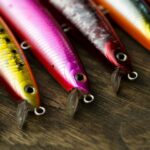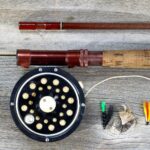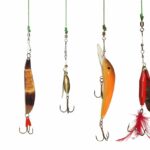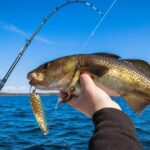Although fishing with lures is highly effective, it’s not always as clear-cut as it seems. You need to consider a plethora of factors when selecting the correct lure for a fishing trip, including the size and style. However, of equal importance is lure color, particularly when fishing in low visibility conditions, like stained water. So if you’re stumped on which to bring, we’ll explore the best lure colors for stained water.
Brightly colored lures work best in lightly stained water bodies, while dark-colored lures are the best choice for heavily stained waters. Heavily stained water has the least visibility, so silhouettes are important. Lures that mimic local bait species are ideal for lightly stained water.
As surprising as it may seem, the lighter-colored lures excel in lightly stained water and vice versa. Below we’ll investigate the disparity between dark and light, why stained water makes a difference, and other factors affecting lure color in stained water.
The Top Lure Colors For Fishing In Stained Water
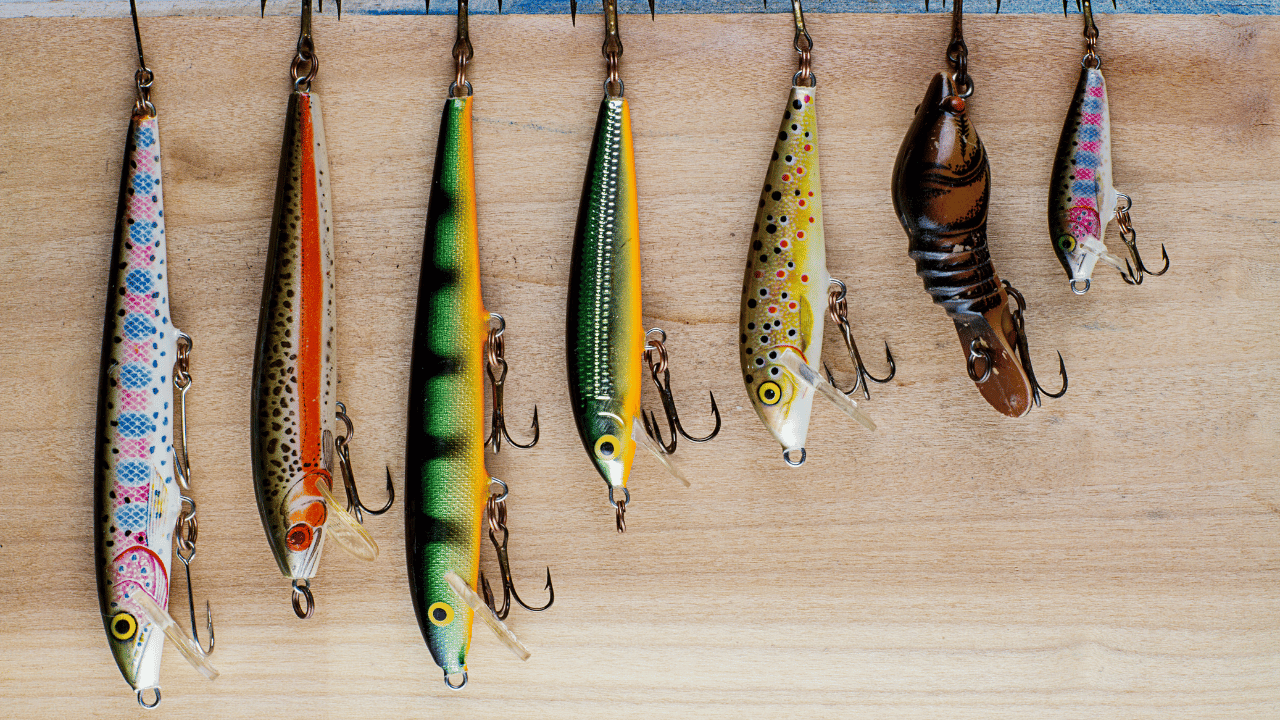
Lure color is a heavily debated topic. Some anglers swear by the tiniest differences, while others prefer a broader approach to the subject.
However, most agree that when fishing in muddy or stained water (discolored), lure color plays a critical role in how successful you are. It’s worth remembering that there are varying levels of “stained” water (turbidity) due to several environmental factors.
The “Turbidity” of the water relates to how many organic and inorganic dissolved substances there are, which makes the water unclear.
We’ll divide the intensity of stained water into lightly, moderately, and heavily stained water.
Although not an exact science, you can tell how turbid (stained) the water is by how far/deep you see through it.
- Clearwater – visibility is unobstructed by dissolved substances. You can see roughly 8 feet or more through the water.
- Lightly stained water-dissolved substances partially obstruct visibility. You can see roughly 4 to 7 feet through the water.
- (Moderately) stained water-dissolved substances obstruct visibility. You can see between 2 and 3 feet through the water.
- Heavily stained water (muddy water) – very little visibility due to dissolved substances. You can see less than 2 feet in the water.
While these guidelines are significantly influenced by variables like current strength, wind, cloud cover, sun angle (and intensity), and your positioning, they are there to “guide” you in determining which lure color is best.
The Best Lure Colors In Lightly Stained Water
Lightly stained water has roughly 4 to 8 feet of visibility, making it relatively easy for fish to see.
When fishing in lightly stained water (visibility is only slightly impaired), the best lures are usually bright colors like orange, red, and chartreuse/luminous yellow (particularly the more stained the water becomes). White and silver are also excellent choices.
Alternatively, selecting lures that mimic your target fish’s food color (brown or green) mixed with these bright colors is a fantastic way to help fish pick out the lure without potentially scaring them with a novel color.
Why Are These Lures Effective In This Environment?
In slightly stained water, the sunlight penetrates deep enough that colorful objects are visible. These brightly colored lures catch the light and “show up” under the water.
They are brightly colored enough that fish can distinguish the lure from the surrounding water, eliciting interest in the fish. White and silver lures excel at reflecting sunlight. Predatory fish are drawn to these flashes.
However, the deeper you fish and the more clouded the water, the less visible these lures become (as sunlight struggles to penetrate through the stained water).
The Best Lure Colors In Heavily Stained Water
Heavily stained water is usually less than 3 feet of visibility (some anglers consider water with less than 2 feet of visibility as “muddy”).
It might surprise you that dark-colored lures work best in heavily stained conditions, particularly black or brown lures.
While many anglers opt for these dark colors, some prefer very bright colors in heavily stained water as their color holds up relatively well. Particularly chartreuse and white.
You could also use gold-colored lures in these conditions as they are similarly effective to other bright lures.
Why Are These Lures Effective In This Environment?
When water is heavily stained, visibility is practically non-existent. Fish rely less on seeing specific colors. Instead, these darker lures create a silhouette (shadow) against a bright background.
I.e., although you can’t see specifics in heavily stained water, the penetrating sunlight hits the lure, which casts a shadow in the water. Fish see this shadow and move in for a strike.
While most anglers agree that darker lures are better for darker stained water, some anglers argue that bright lures stand out better, and gold lures excel in reflecting sunlight (even more than the color silver) in stained water.
The issue with bright-colored lures in these conditions is that light does not penetrate as well, which causes these lures to appear gray, or other colorless shades. Black lures (and other dark colors) are better at drawing in light and cast a superior silhouette.
The Best Lure Colors In Moderately Stained Water
Finding a “middle point” in stained water is generally challenging. However, seeing through moderately stained water is more challenging than slightly stained water.
Depending on how close to heavily stained water you’re fishing in, the rules of either lightly stained (or heavily stained) apply. I.e., if the water is not too turbid, lighter-colored lures or natural colors with dashes of bright colors are effective.
If you’re fishing in water that’s progressing to heavily stained, you’re better off choosing darker colors.
When in doubt, try mixing up your lure colors. Try using brightly colored lures of various shapes and designs at various depths and locations. If these don’t yield the desired results, try switching to a darker lure.
Many anglers agree that black lures are ideal for most water conditions. So if you don’t want to waste too much time, try a black lure.
Two-toned lures are also ideal in many stained conditions. Light may penetrate in strange ways, so a two-toned lure increases the odds of a fish spotting at least one of the colors in the stained water.
Why Are These Lures Effective In This Environment?
Anglers are best served by having a selection of light and dark lures giving you options to switch as required. Fish often surprise us, so being flexible is paramount to success.
If water is not heavily stained, most fish rely on their sense of sight to find prey and are provoked by bright colors. However, as the water becomes darker, they struggle to distinguish color, while shadows are very noticeable.
Other Lure Colors That Anglers Use In Stained Water
Although many anglers follow the principle of “the darker the water, the darker the lure,” some recommend using glow or UV-type lures.
Glow lures store light energy and emit it for several minutes while submerged. This light is visible in low-visibility water and attracts nearby fish to investigate. However, some fish may find the light alarming and avoid the lure.
UV lures are another interesting technology on the market. Recent studies show that some fish species can see ultraviolet light (UV); however, further studies are required.
The difference between UV and glow lures is that while glowing lures store and release energy, UV lures are made from materials that reflect the sun’s UV radiation, increasing the likelihood of fish that can see in the UV spectrum noticing the lure.
Why Lure Color Is Important For Stained Water
Stained water is water that is discolored by dissolved substances, particularly tannins (acidic phenol compounds) from plants (living and decaying plant material in the water) and soils (especially peat).
Aside from leached plant compounds, algae and sediment (clay and silt) create turbid water.
Stained water takes on the appearance of black tea (or weak coffee).
Tannins move down rivers and eventually collect in lakes, creating a brown, almost opaque, soup. Visibility in these conditions is next to nothing because the dissolved particles block/absorb and scatter sunlight, preventing it from penetrating deeper.
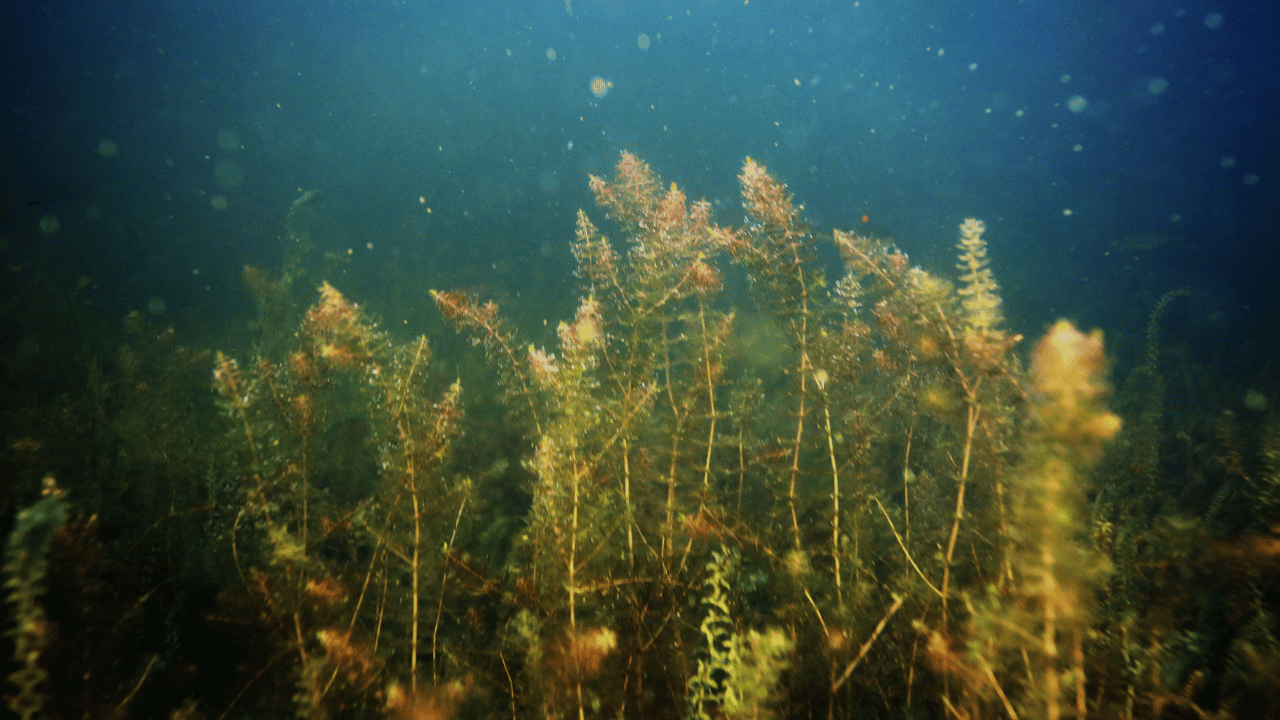
Most predatory fish hunt by a combination of their senses; however, sight plays a fundamental role. By selecting an appropriate lure, you provide fish with a better opportunity to locate it, which (hopefully) leads to a successful catch.
While improving visibility is essential, lure colors also provide fish with novel items, which might garner interest. I.e., a fish might be attracted to a bright or “flashy” lure, particularly if they are becoming dormant as winter draws close.
Fish living in stained water adapt to their environments and eventually notice the tiniest traces of visual cues (color and silhouettes). When fishing with colored lures, you tap into this learned behavior and capitalize on their instinct.
When selecting lure colors, it’s important to try and match the color as best as possible to what your target fish feeds on in the water body. Understanding and knowing your fish’s behaviors is essential to maximize your success rate.
Other Factors Influencing Lure Color In Stained Water
Fishing in stained water is never as “clear-cut” as a textbook says. Various environmental conditions change how fish perceive items in the water.
For example, even within a water body, you’ll have varying degrees of stain depending on where you’re fishing. Whether you’re in a corner, fishing closer or further from a river mouth, or fishing in the middle of a strong current often changes the turbidity.
Sometimes when you fish, “according to historical knowledge,” the odds are still against you. So to give yourself a greater probability of success in stained water, keep a range of colored lures. If one color doesn’t yield the desired results, try switching to a different color or changing your technique.
A fish’s preference and the environmental conditions in the water body vary daily, so being better prepared is a wise idea.
Understanding Your Target Species’ Behavior In Stained Water
Lure shape, color, and vibrations are essential in improving the success rate of fishing in stained water.
However, knowing your target species’ behavior and adjusting your techniques is quintessential to catching fish in stained water.
For example, bass tends to stick to the same locations in clear or stained water; however, they are usually higher up the water column the more stained (turbid) the water becomes.
Water column depth migration is not limited to bass. Walleyes also move into shallower water/higher up the water column in stained water.
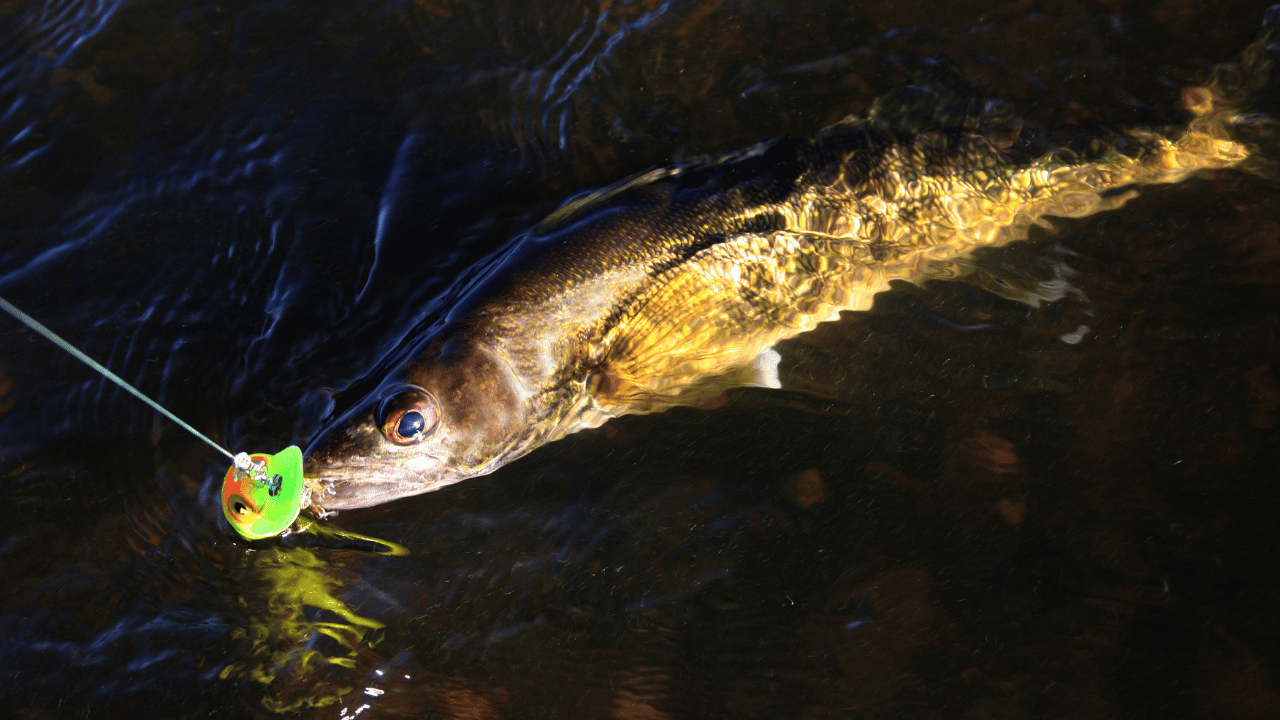
They also use less of their eyesight for acquiring prey and switch to reacting to lateral line stimulation. You improve your success rate by fishing shallower and with a slower retrieval.
Bass (and certain other species) don’t chase prey in heavily stained water, so the slower the retrieval, the greater the chance of a strike. Further, many fish stick closer to obstacles/structures when the water is stained, so targeting these areas yields better results.
Ideally, you want to select lures that imitate the local baitfish in the waterbody as predatory fish are used to hunting these fish in most water conditions. The closer you get to the specific baitfish, the better your chances.
Stained water usually warms up quicker than clear water (more of the sun’s energy is absorbed), which means certain fish, like bass, warm up quicker and become more aggressive.
Stained water also gives many fish species a greater sense of “safety” from predators, and they take advantage of this to attack novel-colored lures.
Does Lure Type Synergize With Lure Color In Stained Water?
The style of the lure also plays a role in influencing how well a particular color works.
For example, diving lures “swim” at greater depths in the water column, often putting them into darker cloudy/turbid water regions. These lures benefit from darker natural colors, with a splash of color mixed in.
Topwater lures are relatively easier to see in most water conditions, provided the fish is close enough to see it. These lures benefit from lighter colors like shad (silver, white, blue, etc.), chartreuse, orange, red, and greens.
Where a fish sits in the water body plays a significant role when fishing in stained water as your lure selection may change (divers vs. top water soft plastics).
In stained conditions, selecting a larger lure helps to cast a larger silhouette, improving the likelihood of a fish noticing it as you slowly retrieve, while smaller lures may go unnoticed.
Some anglers upscale their lures by around 20% when fishing in stained water (it is necessary to still select a lure size appropriate for your target species).
Lure Color Is Not The Only Factor When Fishing In Stained Water
The most effective lures for stained water are those which are visible and those that vibrate.
In low visibility water (like stained), fish depend less on their eyesight, and many species sense movements and vibrations in the water.
Rattles, spinners, wobblers, and similar vibration-producing lures drastically improve the odds of catching fish (paddle tail worms are a popular choice). If your toolkit lacks these lures, there are line rattles that you can add to supplement the noise production.
Aside from “noise,” some fish (like catfish) rely on their sense of smell when hunting. Various soft plastics are scented (or you can add a scent) and are incredibly effective in attracting fish.
Alternatively, a ribbed soft plastic bait’s ability to trap and release bubbles while you retrieve will also attract fish to the lure.
The Weather Influences Which Lure Colors Work Best
Weather (like water turbidity) influences which colors work best. Fortunately, the patterns are similar.
On a bright, sunny day, lighter, transparent lures are the best, particularly those with natural coloration (green, brown, some yellow, etc.).
On cloudy/dark days, dark-colored lures are more effective, including browns and blacks, thanks to the same principle that stained water lures follow, i.e., dark lures produce a better silhouette in poor light/visibility conditions. Fish see these silhouettes and perceive them as food.
So when fishing in stained water on a dark day, the best bet is using darker-colored lures.
Conclusion
While it may seem counterintuitive, darker-colored lures, like black, work better in heavily stained water thanks to the silhouette they cast. However, some bright colors also show up relatively well. In less stained water, bright colors work well, and the closer you get to mimicking local bait fish, the better your chances become. Aside from color, sounds/vibrations and scents improve your fishing success in stained water.
- Do You Need An Indicator For Nymph Fishing? - November 16, 2023
- Fishing Safety Tips For Families - September 25, 2023
- What Is The Best Time To Night Fish At A Lake? - September 18, 2023


